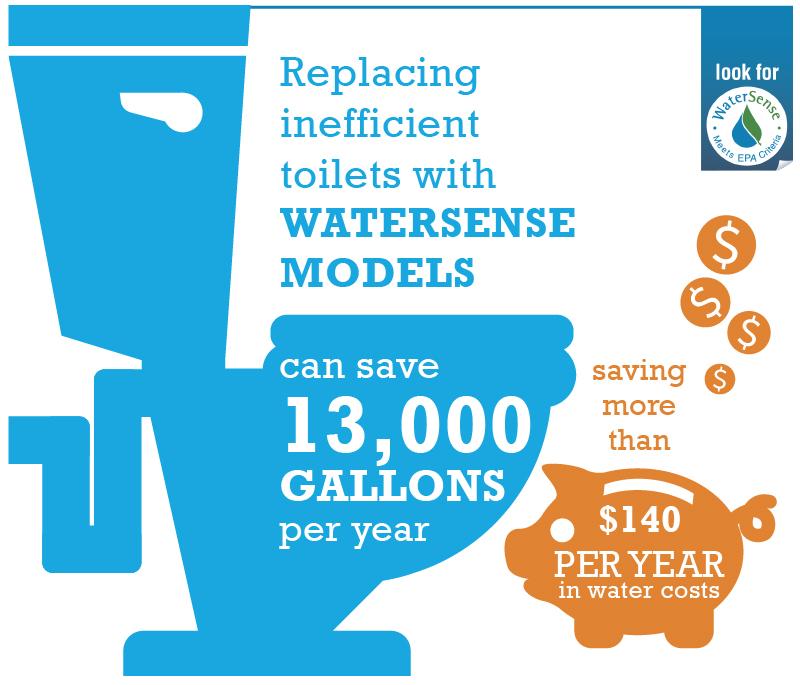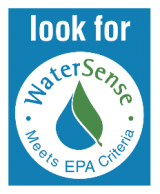Residential Toilets

![]() Toilets are by far the main source of water use in the home, accounting for nearly 30 percent of an average home's indoor water consumption. Older, inefficient toilets that use as much as 6 gallons per flush also happen to be a major source of wasted water in many homes.
Toilets are by far the main source of water use in the home, accounting for nearly 30 percent of an average home's indoor water consumption. Older, inefficient toilets that use as much as 6 gallons per flush also happen to be a major source of wasted water in many homes.
On This Page:
Flush Facts
Recent advancements have allowed toilets to use 1.28 gallons per flush or less while still providing equal or superior performance. This is 20 percent less water than the current federal standard of 1.6 gallons per flush. The WaterSense label is used on toilets that are independently certified to meet rigorous criteria for both performance and efficiency. Only water-saving toilets that complete the certification process can earn the WaterSense label.
Whether remodeling a bathroom, starting construction of a new home, or simply replacing an old, leaky toilet that is wasting money and water, installing a WaterSense labeled toilet is a high-performance, water-efficient option worth considering. WaterSense labeled toilets are available at a wide variety of price points and a broad range of styles and in many areas, utilities offer rebates and vouchers that can lower the price of a WaterSense labeled toilet.
A WaterSense Labeled Toilet Factsheet(1 pp, 296 K, About PDF) is also available in PDF.
WaterSense Savings
 By replacing old, inefficient toilets with WaterSense labeled models, the average family can reduce water used for toilets by 20 to 60 percent—that's nearly 13,000 gallons of water savings for your home every year! They could also save more than $140 per year in water costs, and $2,900 over the lifetime of the toilets.
By replacing old, inefficient toilets with WaterSense labeled models, the average family can reduce water used for toilets by 20 to 60 percent—that's nearly 13,000 gallons of water savings for your home every year! They could also save more than $140 per year in water costs, and $2,900 over the lifetime of the toilets.
Nationally, if all old, inefficient toilets in the United States were replaced with WaterSense labeled models, we could save 360 billion gallons of water per year, or the amount of water that flows over Niagara Falls in about 9 days.
Household leaks can waste 180 gallons per week. Toilets are often the culprit. If your toilet has a leak most likely it is due to an old or worn-out toilet flapper (e.g., valve seal) which can cause leaks. Flappers are inexpensive rubber parts that can build up minerals or decay over time. Replacing them is quick and easy. To see how easy it is check out the WaterSense Bath Hack Video #3.
- WaterSense Bath Hack #3 shows how easy it is to Replace Your Leaky Toilet Flapper. EXIT
Specification
On June 2, 2014, EPA released a revised version of the WaterSense Specification for Tank–Type Toilets (Version 1.2). The specification changes are minor in nature and are intended to provide clarification of the existing requirements. The changes also align the specification with recent revisions to the American Society of Mechanical Engineers (ASME) A112.19.2/Canadian Standards Association (CSA) B45.1 Ceramic Plumbing Fixtures standard and ensure that tank-type toilets receiving the WaterSense label are certified and labeled consistently, in accordance with EPA’s intent, and will continue to meet consumer expectations for efficiency and performance.
- Version 1.2 of the WaterSense Specification for Tank-Type Toilets (PDF) (6 pg, 48K, About PDF)
- Summary of Revisions to the WaterSense Specification for Tank-Type Toilets (Version 1.2) (PDF) (5 pg, 52K, About PDF)
Version 1.2 of the WaterSense Specification for Tank-Type Toilets replaces Version 1.1, which EPA released on May 24, 2011. For more information about the WaterSense specification development process for toilets, please see the Tank-Type Toilet Specification Background Materials page.
Manufacturers that produce tank-type toilets meeting EPA's efficiency and performance criteria can apply to have their products certified to earn the WaterSense label. Before submitting products for testing, manufacturers must have a partnership agreement with EPA in place. Visit the manufacturer section on the partner page to learn more.

